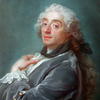More about Venus at Vulcan's Forge

Contributor
François Boucher brings capitalism to art history.
Boucher didn’t care about the purity of art—he built a recognizable personal brand and sold the heck out of it in prints, on porcelain, and tapestries—he is Mr. Rococo. Critics at the time had mixed feelings about his stuff, one said “he can make anything—except the truth,” and today art teachers are still getting fired for showing students Boucher’s work (ok but more for the nudity than the objective artistic quality). But his tapestries were presented as a gift to the Qianlong emperor making him the voice of the 18th century French sensibility, or as one critic put it, “Boucher was not only its painter, but...its very type.”
Venus at Vulcan’s Forge was one of six works painted for an hôtel in Paris. An hôtel is an urban mansion, not a Motel 6 hotel, though now it’s a school (French Revolution etc.) but you can still see the fancy carriage doors at 3 rue Béranger. Anyway, Boucher was strictly about pleasure. Ostensibly the scene is about Venus shopping for weapons for her not-god son Aeneas to use against the Trojans, but look at this painting, it’s dripping with millennial pink and hot almost-nudes and seems entirely unconcerned with war and any other unpleasant things. That baby in Vulcan’s lap means that Venus is in full control (mhm yeah she is), he’s handing his sword (“sword”) over to her like a rose but she’s more interested chilling in clouds with her girls. If you didn’t know the mythological reference you’d probably think this was some soft-erotica cosplay fanart.
Boucher was criticized in the 1760s for his “attachment to a purely fictive universe.” Democratic sentiments were heading towards revolution in America and France, the public was becoming aware of its terrible poverty, and Boucher kept stubbornly painting pretty things for rich people. But his brand of Rococo seems like it’s about to have a resurgence—living in a “fictive universe” and an obsession with drowning all the noise of ennui with pink clothes and soft skin is basically what we’re all about these days.
Sources
- Goncourt, Edmond and Jules, 1861. Quoted in Jane Clark and Patrick McCaughney. “Love among the ruins: two pastorals by François Boucher.” Art Bulletin of Victoria, Edition 23, 1982. Accessed June 25, 2018. https://www.ngv.vic.gov.au/essay/love-among-the-r
- Goukassian, Elena. “Utah Schoolteacher Fired for Showing Postcards of Nude Paintings in Art Class.” Hyperallergic. January 2, 2018. Accessed June 25, 3018. https://hyperallergic.com/419735/utah-art-teacher-fired-over-nude-paint…
- Smentek, Kristel. “Chinoiseries for Beijing: An Eighteenth Century French Gift to the Emperor of China.” The Frick Collection. Video, 1:04:35, October 21, 2015. Accessed June 25, 2018. https://www.frick.org/interact/kristel_smentek_chinoiseries_for_beijin
- Stein, Perrin. “François Boucher (1703–1770).” Heilbrunn Timeline of Art History. New York: Metropolitan Museum of Art, October 2003. Accessed June 25, 2018. https://www.metmuseum.org/toah/hd/bouc/hd_bouc.htm
- “The Genius of the French Rococo: The Drawings of François Boucher (1703–1770) and Boucher’s Mythological Paintings: The Last Great Series Reunited.” Kimbell Art Museum, 2017. Accessed June 25, 2018. https://www.kimbellart.org/exhibition/genius-french-roc
- “Venus at Vulcan’s Forge.” Kimbell Art Museum, 2017. Accessed June 25, 2018. https://www.kimbellart. org/collection-object/venus-vulcans-forge












Superb insights. Jay Myers